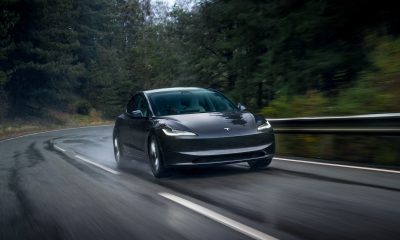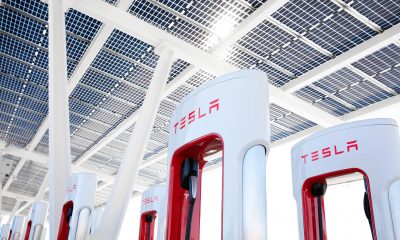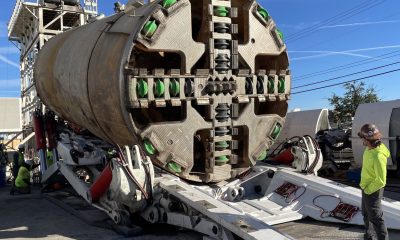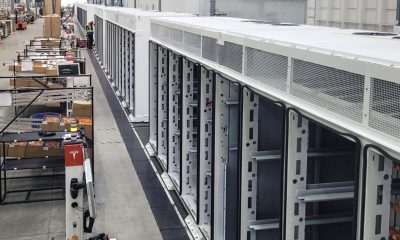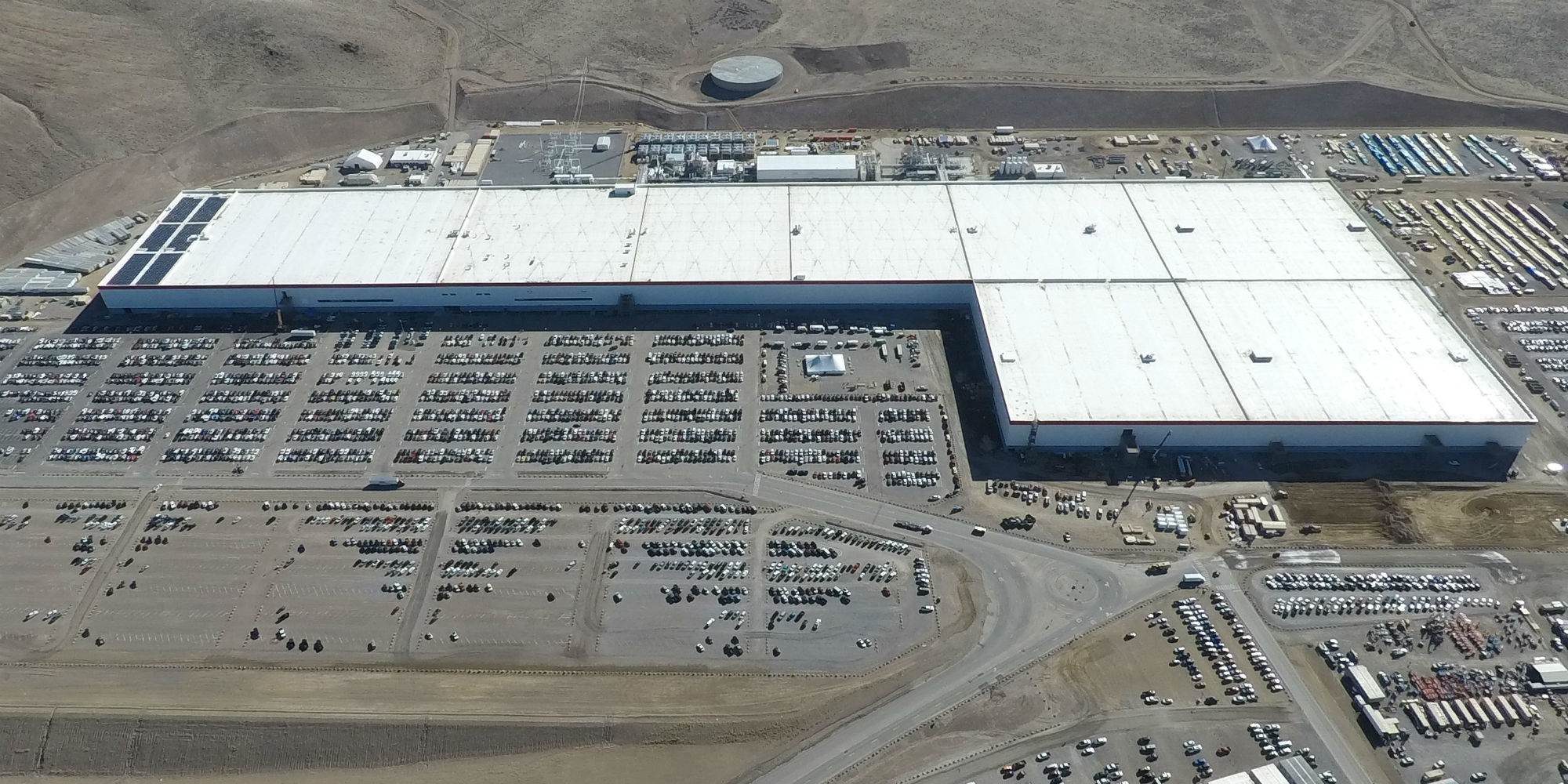

Energy
Tesla battery partner Panasonic debunks rumors about alleged Gigafactory 1 conflicts
Panasonic Corporation President Kazuhiro Tsuga effectively debunked speculations alleging that the Japanese company’s relationship with American electric car maker Tesla is on the rocks. During a recent Q&A session, Tsuga explained the dynamic between Tesla and Panasonic, as well as his insights about the idea of the electric car maker utilizing another battery supplier for Gigafactory 3.
The relationship between Tesla and Panasonic was thrown into question following a report from the Nikkei Asian Review last month, which alleged that the Japanese company was freezing its investments in Gigafactory 1. Tesla responded to the report, stating that there is far more output to be gained by improving the existing production lines in the Nevada-based factory. Elon Musk took to Twitter as well, stating that Panasonic’s lines at Gigafactory 1 are only operating at ~24 GWh per year despite having a theoretical capacity of 35 GWh.
Musk’s tweets were promptly interpreted as a “public battle” with Panasonic. Craig Irwin of Roth Capital Partners noted that “Tesla and Panasonic need couples counseling ASAP,” adding that “this is looking like a much more acrimonious relationship.” Tsuga, for his part, mentioned that Tesla and Panasonic maintain a “very good relationship between ourselves” during the Q&A session. Explaining further, the Panasonic President pointed out that the two companies have always been candid with each other, especially when it comes to investments in facilities such as Gigafactory 1.
“(In) the earlier session with the media, there was a question as to (whether) we have (a) bad relationship, (or if) we’re not getting along with Tesla. Well, we are making sure that we have a partnership relationship, not a supplier relationship. And since we are partners, we are very frank and candid and honest to each other. So on this battery business, as for the investment facilities — for the facilities that we have invested, can we maintain the battery operation with the orders coming in? From Tesla’s point of view, with the batteries being supplied, they can manufacture their vehicles on a full capacity basis.
“Unless that is established, this would not be a win-win relationship. In the past, what hurt us (was) that we were told that ‘This is the capacity you’ll need,’ but we couldn’t sell that much batteries. That’s the worst case. And that sense, Tesla is purchasing everything that we manufacture. And they have not just the electric vehicles but they do have the storage batteries as well, and they are asking for the capacity increase all the time. And therefore, we have capacity but not being produced. That situation is not envisioned for Gigafactory for now. So I think we have a very good relationship between ourselves,” Tsuga said.
Other concerns that were brought forward on the heels of the Nikkei report were Panasonic’s speculated issues about Tesla’s potential local battery partner in Gigafactory 3. Tesla is speculated to utilize a local battery supplier for the Shanghai-based electric car production facility, a strategy that analysts such as Cairn Energy Research Advisors managing director Sam Jaffe believed would irk Panasonic. “Tesla is starting to flirt with other battery makers in China, and Panasonic doesn’t like that,” Jaffe said in a statement to the Los Angeles Times.
Panasonic President Tsuga expressed a completely different sentiment about the topic, noting that it makes sense for Tesla to adopt a multiple supplier model for Gigafactory 3. “Now because of what happens in China, Tesla is considering a multiple supplier structure, which makes sense for Tesla maybe given the very special nature of doing business in China, and maybe they need to have that structure so as to be approved by China authority. So on the part of Tesla, they might prefer — they might start considering getting multiple suppliers, but that doesn’t mean that our relationship is being hurt and is being unstable, no. We continue to have very solid, very strong relationship with Tesla,” Tsuga said.
Panasonic and Tesla have been in a close working relationship for years. The Japanese company currently produces the battery cells for Tesla’s vehicles, from the 18650 cells used in the Model S and Model X to the 2170 cells utilized in the Model 3. Considering the recent statements of the Panasonic President, as well as Tesla’s ramp of its existing and upcoming products, it appears that the two companies’ partnership will likely remain strong for some time to come.

Energy
Tesla starts hiring efforts for Texas Megafactory
Tesla’s Brookshire site is expected to produce 10,000 Megapacks annually, equal to 40 gigawatt hours of energy storage.

Tesla has officially begun hiring for its new $200 million Megafactory in Brookshire, Texas, a manufacturing hub expected to employ 1,500 people by 2028. The facility, which will build Tesla’s grid-scale Megapack batteries, is part of the company’s growing energy storage footprint.
Tesla’s hiring efforts for the Texas Megafactory are hinted at by the job openings currently active on the company’s Careers website.
Tesla’s Texas Megafactory
Tesla’s Brookshire site is expected to produce 10,000 Megapacks annually, equal to 40 gigawatt hours of energy storage, similar to the Lathrop Megafactory in California. Tesla’s Careers website currently lists over 30 job openings for the site, from engineers, welders, and project managers. Each of the openings is listed for Brookshire, Texas.
The company has leased two buildings in Empire West Business Park, with over $194 million in combined property and equipment investment. Tesla’s agreement with Waller County includes a 60% property tax abatement, contingent on meeting employment benchmarks: 375 jobs by 2026, 750 by 2027, and 1,500 by 2028, as noted in a report from the Houston Business Journal. Tesla is required to employ at least 1,500 workers in the facility through the rest of the 10-year abatement period.
Tesla’s clean energy boom
City officials have stated that Tesla’s arrival marks a turning point for the Texas city, as it highlights a shift from logistics to advanced clean energy manufacturing. Ramiro Bautista from Brookshire’s economic development office, highlighted this in a comment to the Journal.
“(Tesla) has great-paying jobs. Not just that, but the advanced manufacturing (and) clean energy is coming to the area,” he said. “So it’s not just your normal logistics manufacturing. This is advanced manufacturing coming to this area, and this brings a different type of job and investment into the local economy.”
Energy
Tesla and Samsung SDI in talks over new US battery storage deal: report
The update was related by industry sources and initially reported by South Korean news outlets.

Recent reports have suggested that Tesla and Samsung SDI are in talks over a potential partnership to supply batteries for large-scale energy storage systems (ESS).
The update was related by industry sources and initially reported by South Korean news outlets.
ESS batteries to be built at Samsung’s Indiana plant
As noted in a report from Korea JoongAng Daily, the demand for energy storage systems has been growing rapidly in North America, thanks in no small part to the surge in AI investments across numerous companies. With this in mind, Tesla has reportedly approached Samsung SDI about a potential battery supply deal.
The deal is reportedly worth over 3 trillion Korean won (approximately $2.11 billion) and will span three years, according to The Korea Global Economic Daily. A battery supply deal with Samsung SDI could make sense for Tesla as the company already has a grid-scale battery, the Megapack, which is perfect for industrial use. Samsung SDI could simply supply cells for the EV maker.
Production of the batteries would reportedly take place at Samsung SDI’s joint venture factory with Stellantis in Indiana, which is currently under construction. Samsung SDI recently announced plans to use part of that plant’s EV lines to produce cells for ESS, with a targeted capacity of 30 GWh by the end of next year.
Tesla and Samsung’s partnership
At present, only a handful of manufacturers, including Korea’s LG Energy Solution, Samsung SDI, SK On, and Japan’s Panasonic, are capable of producing energy storage-scale batteries domestically in the United States. A Samsung SDI official issued a comment about the matter, stating, “Nothing has been finalized regarding cooperation with Tesla.”
The possible energy storage system deal adds another layer to Tesla’s growing collaboration with Samsung, which is already in line as a partner in the upcoming production of Tesla’s AI5 and AI6 chips. Early sample manufacturing of the AI6 is expected to begin in South Korea, with mass production slated for Samsung’s Texas-based Taylor foundry when it starts operations.
The AI6 chip will power Tesla’s next wave of high-volume projects, including the Optimus humanoid robot and the autonomous Cybercab service. Musk has called the partnership with Samsung a “real collaboration,” adding that he personally plans to “walk the line” at the Taylor facility to speed up progress.
Energy
Tesla VP hints at Solar Roof comeback with Giga New York push
The comments hint at possible renewed life for the Solar Roof program, which has seen years of slow growth since its 2016 unveiling.

Tesla’s long-awaited and way underrated Solar Roof may finally be getting its moment. During the company’s Q3 2025 earnings call, Vice President of Energy Engineering Michael Snyder revealed that production of a new residential solar panel has started at Tesla’s Buffalo, New York facility, with shipments to customers beginning in the first quarter of 2026.
The comments hint at possible renewed life for the Solar Roof program, which has seen years of slow growth since its 2016 unveiling.
Tesla Energy’s strong demand
Responding to an investor question about Tesla’s energy backlog, Snyder said demand for Megapack and Powerwall continues to be “really strong” into next year. He also noted positive customer feedback for the company’s new Megablock product, which is expected to start shipping from Houston in 2026.
“We’re seeing remarkable growth in the demand for AI and data center applications as hyperscalers and utilities have seen the versatility of the Megapack product. It increases reliability and relieves grid constraints,” he said.
Snyder also highlighted a “surge in residential solar demand in the US,” attributing the spike to recent policy changes that incentivize home installations. Tesla expects this trend to continue into 2026, helped by the rollout of a new solar lease product that makes adoption more affordable for homeowners.
Possible Solar Roof revival?
Perhaps the most intriguing part of Snyder’s remarks, however, was Tesla’s move to begin production of its “residential solar panel” in Buffalo, New York. He described the new panels as having “industry-leading aesthetics” and shape performance, language Tesla has used to market its Solar Roof tiles in the past.
“We also began production of our Tesla residential solar panel in our Buffalo factory, and we will be shipping that to customers starting Q1. The panel has industry-leading aesthetics and shape performance and demonstrates our continued commitment to US manufacturing,” Snyder said during the Q3 2025 earnings call.
Snyder did not explicitly name the product, though his reference to aesthetics has fueled speculation that Tesla may finally be preparing a large-scale and serious rollout of its Solar Roof line.
Originally unveiled in 2016, the Solar Roof was intended to transform rooftops into clean energy generators without compromising on design. However, despite early enthusiasm, production and installation volumes have remained limited for years. In 2023, a report from Wood Mackenzie claimed that there were only 3,000 operational Solar Roof installations across the United States at the time, far below forecasts. In response, the official Tesla Energy account on X stated that the report was “incorrect by a large margin.”
-

 News6 days ago
News6 days agoTesla shares rare peek at Semi factory’s interior
-

 Elon Musk6 days ago
Elon Musk6 days agoTesla says texting and driving capability is coming ‘in a month or two’
-

 News5 days ago
News5 days agoTesla makes online ordering even easier
-

 News5 days ago
News5 days agoTesla Model Y Performance set for new market entrance in Q1
-

 News6 days ago
News6 days agoTesla Cybercab production starts Q2 2026, Elon Musk confirms
-

 News6 days ago
News6 days agoTesla China expecting full FSD approval in Q1 2026: Elon Musk
-

 News7 days ago
News7 days agoTesla Model Y Performance is rapidly moving toward customer deliveries
-
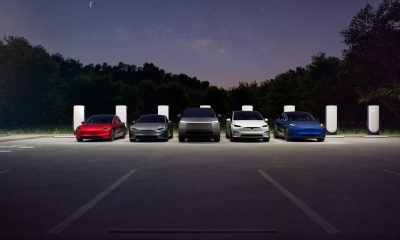
 News4 days ago
News4 days agoTesla is launching a crazy new Rental program with cheap daily rates


